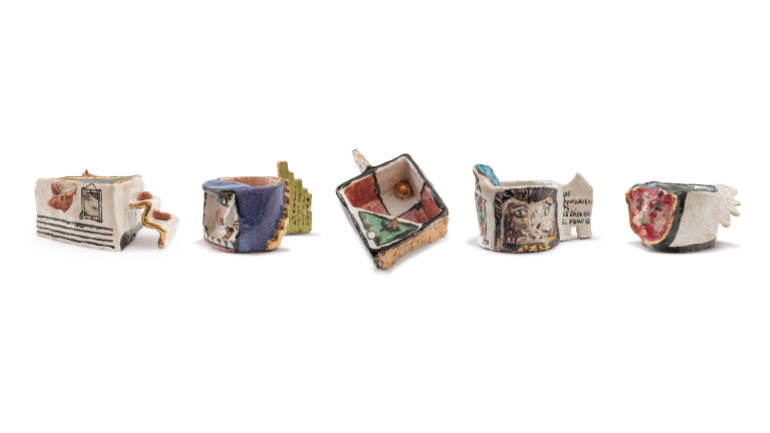Object Stories
Object Stories
Handmade objects – and the stories they carry and inspire – are catalysts for a deeper engagement with the world and ourselves. Inspired by the 50th anniversary of “Objects USA” and the Portland Art Museum’s Object Stories, an ongoing community storytelling project and exhibition series, we invited multidisciplinary artists Jillian Mayer and Nicholas Galanin, chef Sean Sherman, and scholars Tina Oldknow and Lowery Stokes Sims to write about objects that hold meaning for them. The pieces they present shed light on their individual perspectives and underscore what is shared in our multifarious community: that the objects we make, admire, live with, and inherit are much more than things. They are the embodiment of history, culture, and skill – and a testament to what we hold dear. These are their stories.
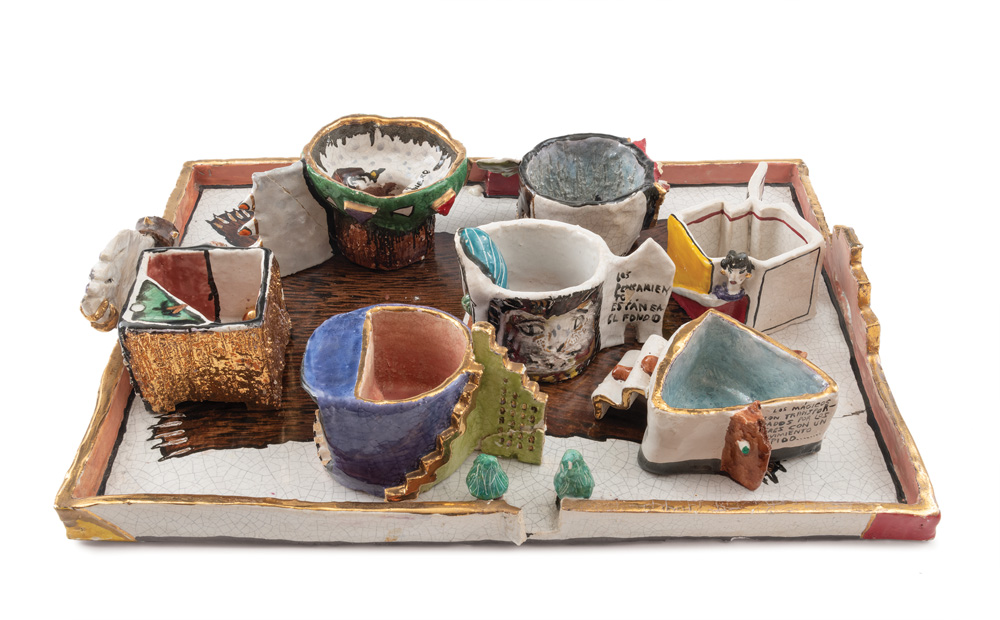
Julio Galán’s Los Mágicos son transportados por los aires con un movimiento rápido (The magicians are transported through the air with a rapid movement) / Photo: Adam Reich Photography
by Lowery Stokes Sims
Although the Mexican painter Julio Galán (1958 – 2006) was associated with two neo-figural art movements of the 1980s, neo-expressionism in New York and neo-Mexicanismo in Mexico, critic Roberta Smith perhaps described his style best when she called it “a kind of postmodern symbolism: over-ripe, often perverse, yet mesmerizing.”
I met Galán when I made a side trip to Monterrey, Mexico, in the mid 1980s while transporting work on loan from the Metropolitan Museum of Art to the Tamayo Museum in Mexico City. In his studio I was particularly drawn to a ceramic tray with idiosyncratically shaped cups, a work imbued with that mesmerizing quality. The tray features the image of a flayed bearskin on its surface and its edges are built up to mimic an adobe fence that culminates in a gable form, like the entrance to an ecclesiastical enclosure. Two small shrubs flank a smaller gate, granting access to the space, while an outsized hand, festooned with rings and wearing a studded wrist ornament, rises opposite the gable form.
On the cups, Galán deployed a variety of effects, including stippling and scoring the surfaces and inscribing them with terse haiku-like statements that tease, tempt, even taunt the viewer to look at them more closely. He also sculpted intimate scenes and enigmatic figures onto the bodies of the cups, defying many of the protocols of ceramics in ways that only an artist making a one-time foray into a new medium can. (This attention to surface texture can be seen in Galán’s paintings and works on paper, too. He was fond of adding beads, fragments of jewelry, and even dried flowers to them.)
I expressed my admiration for this “tea set,” if that’s what it was, and left his studio with a nagging desire to possess the quirky ensemble, unique in Galán’s oeuvre. Since I never voiced this feeling, imagine my surprise when a few months later one of his friends arrived at my apartment in New York City with the work in tow. Over the years it has survived the slings and arrows of my life, although Galán’s lack of skill in the medium has meant that a few of the cups have suffered breakage, which I repair diligently. Despite the brevity and infrequency of our association, Julio Galán remains in my memory as one of the most remarkable artists I have ever met, and his “tea set” still seems to be a quintessential expression of his mesmerizing self-exploratory impulse.
Lowery Stokes Sims is the retired curator emerita at the Museum of Arts and Design.
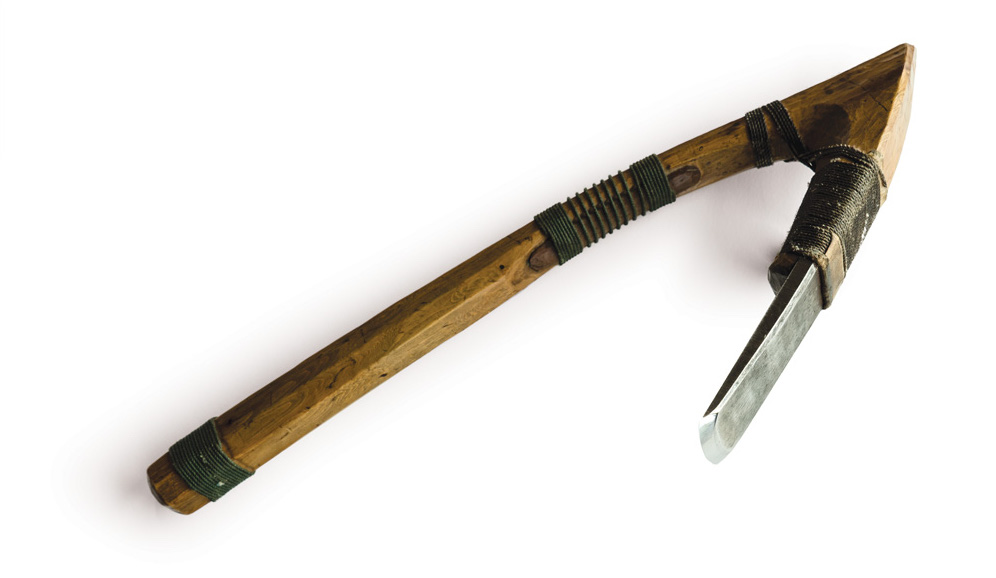
Xut´aa “The one that chips” (Tlingit) / Photo: Nicholas Galanin
by Nicholas Galanin
I share this photo and this tool with you: the elbow adze, an extension of the hand, a tool that holds connection to land and generational knowledge, a tool used in a healing rhythm that intrinsically works slowly, a tool tempered and sharp. The knowledge that goes into its making and maintenance is the same knowledge that is applied to the work the tool has been designed for: carving wood, sculpting totems and canoes. The work it has been made for is based on connection: to place, to the past, to today, to the supernatural, to tomorrow.
Nicholas Galanin (Tlingit/Unangax) is a multidisciplinary artist and musician living in Sitka, Alaska.
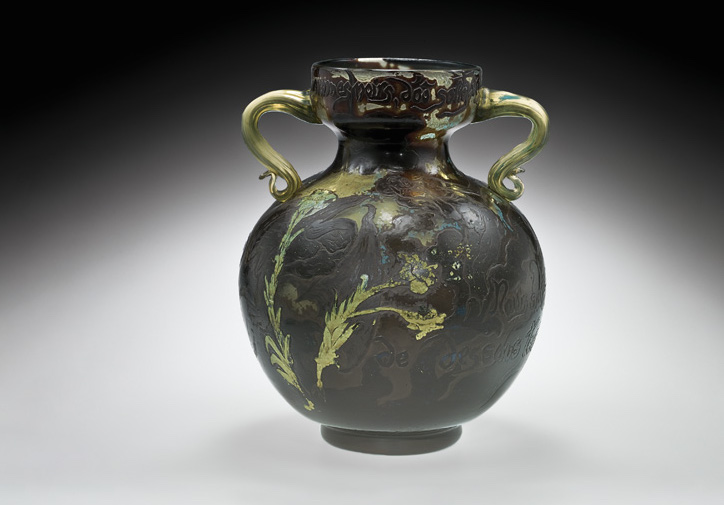
Les Hommes Noirs / Photo: The Corning Museum of Glass
by Tina Oldknow
As the former curator of modern and contemporary glass at the Corning Museum of Glass, I was fortunate to make many purchases for the museum’s collection.
The most important of these, for me, was a vase titled Les Hommes Noirs, or The Dark Men. Made in 1900, its decoration pinpointed a particular place and a troubled moment in time.
The vase’s decoration refers to the Dreyfus Affair, one of the most divisive scandals in modern French history. The affaire concerned the wrongful conviction for treason of a French Jewish captain, Alfred Dreyfus, and the subsequent cover-up involving the “dark men” of the French military and judicial system, and the Catholic church.
At the time of its purchase in 2011, I couldn’t know how clearly the message of this artwork would continue to sound in the politically dark times of America today.
The vase was designed by French art nouveau glassmaker Émile Gallé in collaboration with romantic painter and sculptor Victor Prouvé. At 38 inches tall, the piece is overly large and therefore risky to execute, making it a glassblowing challenge for Gallé’s studio. It was also one of the highlights of his controversial display at the 1900 Paris World’s Fair. There, to millions of people, a despairing Gallé displayed a series of objects that used allegorical imagery to express his democratic sympathies and protest the evils of fanaticism, hatred, lies, prejudice, and hypocrisy in French government and society.
The play of darkness and light was a metaphor frequently used by Gallé to symbolize the battle between good and evil. The shadowy, monstrous figures etched on the vase are interposed with three large yellow lilies, which represent Dreyfus’ innocence.
The most powerful works of art are those that resonate across time and place, and Les Hommes Noirs does just that. After more than a century, its themes – denouncing “fake facts,” anti-Semitism, and political manipulation, while calling for resistance – are still charged with meaning.
Tina Oldknow is an author and curator in New Mexico.
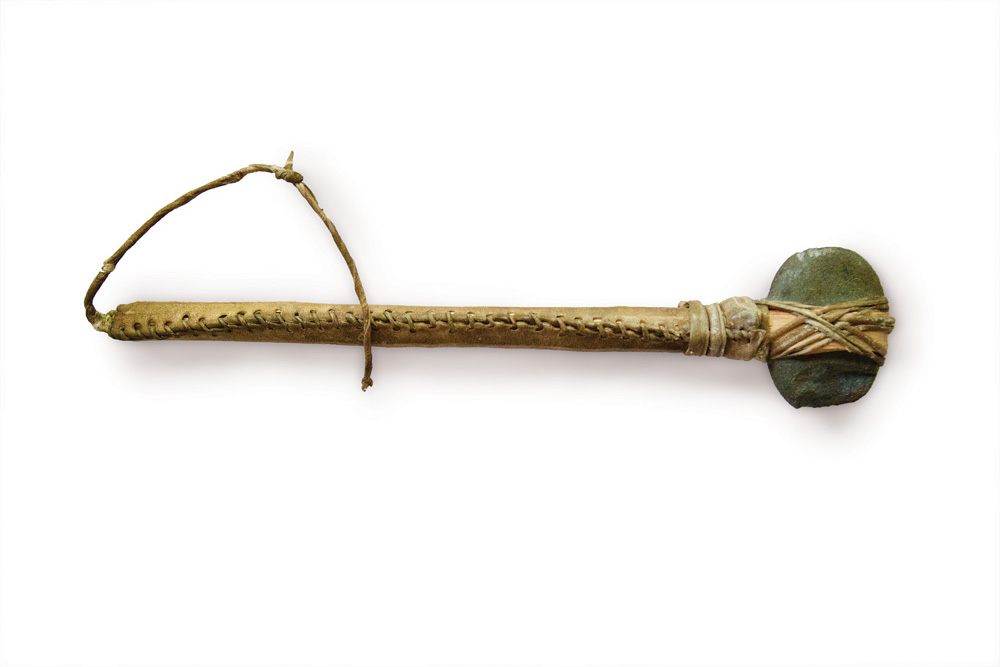
Canwiyape tool for pounding seeds, nuts, corn, and meat (Lakota) / Photo: Sean Sherman
by Sean Sherman
My family is from the Pine Ridge Reservation, situated on the southern border of South Dakota, and we are enrolled in the federally recognized Oglala Lakota Sioux Tribe. This canwiyape, a simple tool made of stick, stone, and bison leather, was among my great-grandfather’s possessions.
I reflect often on his life, as he witnessed a drastically changing world. Born on the Great Plains in the late 1850s, he had a traditional Lakota education: horseback riding, crafting bows and tools, hunting, identifying plants and medicines, and, most importantly, learning stories and oral histories. During his lifetime, he was in battles between the Oglala Lakota and the US Government, including the defeat of General Custer in the Battle of Greasy Grass (Battle of the Little Bighorn) in 1876. Soon after, he witnessed the surrender of the Oglala leader Crazy Horse, the formation of the reservation I grew up on, and the horrific Wounded Knee Massacre of 1890. He saw his children forced to attend boarding schools during the assimilation efforts of the late 1800s (which lasted well into the 20th century), during which they had their hair cut short and were forbidden to speak Lakota. He eventually lived to see those same children and their descendants fight for the US in both world wars.
This canwiyape, an everyday tool, represents history and change for me, a voice from the past. It’s a woman’s tool, possibly my great-great-grandmother’s, that would have been worn at all times for daily tasks such as cutting plants, scraping hides, and pounding nuts, seeds, and meats. I imagine the gatherings this tool witnessed, filled with songs, stories, and deliberations of how to hold onto traditions and survive so much change. As a chef and educator, I work to raise awareness of Indigenous perspectives through foodways and to build a more sustainable food future by embracing regional and cultural diversities. This tool represents an idea and a spirit that has never died, a symbol of resistance in the face of oppression, a spirit of resilience through decades of assimilation, and the beauty of simplicity in the era of technology. It is not only a personal connection to the past but a key to the future.
Sean Sherman is a chef, cookbook author, educator, and promoter of Indigenous cuisine.
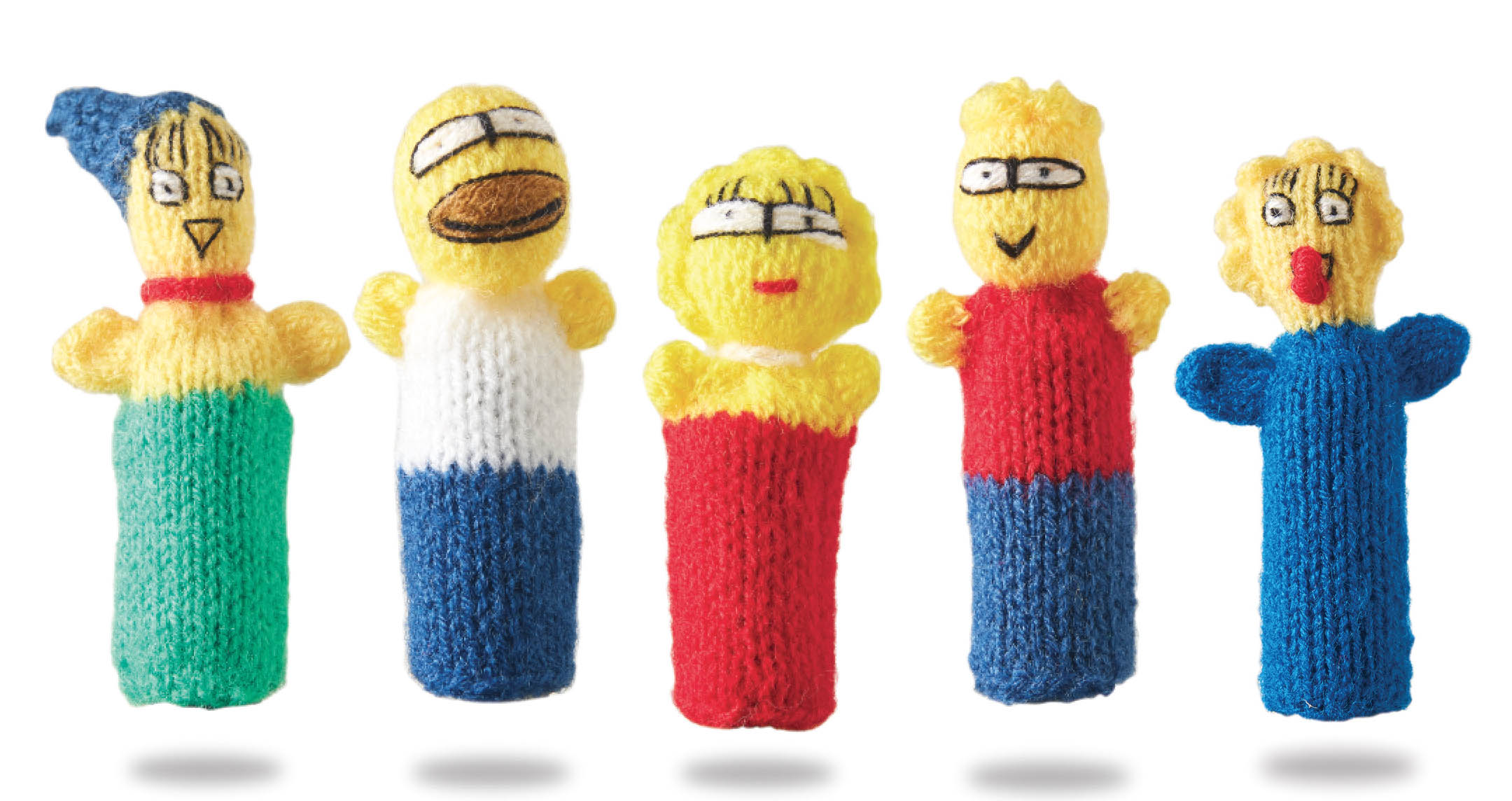
Los Simpsons / Photos: Mark LaFavor
by Jillian Mayer
While traveling in South America in 2010, I stopped in the Miraflores district of Lima, Peru. Open-air markets selling crafts lined many of the alleys and streets of the neighborhood, and I found myself returning again and again to the colorfully dressed craftswomen selling their wares.
Their tables were filled with a whole galaxy of handmade items, but I was mostly attracted to big baskets of brightly colored finger puppets made of yarn. Renditions of animals and cars dominated, but I fell in love with the Simpsons characters I could find here and there.
If I couldn’t find a given character, I would ask the women for it by name, but that usually went nowhere. I had the feeling they weren’t aware that these were TV characters at all. Perhaps they saw them not as the animated family I knew so well but simply as little yellow human beings.
Finding these finger puppets became a scavenger hunt for me as I visited various parts of South America. I eventually accumulated a varied array of more than 30 Homers and 17 Marges. Lisa was the hardest to locate, and when I was on the trail of Maggie, I had to refer to her simply as “Bébé.”
I left Peru and traveled to a friend’s home in Argentina. Over dinner, she turned on the TV and settled on, yes, The Simpsons, dubbed in Spanish. It seemed like the perfect moment for me to open my backpack and pour out more than 50 Simpsons finger puppets onto the table.
I love the way mass media culture and animated cartoons can be a part of so many people’s lives simultaneously – whether they realize it or not. We all grew up with The Simpsons, and they grew up with us.
In “Family Matters,” my first solo show at Miami’s David Castillo Gallery in 2011, I used many of these Homers and Marges to dress the cast plaster hands I made. Now these little puppets are scattered around my art studio and home. Occasionally, I find one in a pocket of a jacket.
Miami artist Jillian Mayer makes work that explores how technology affects our lives, bodies, and identities.
